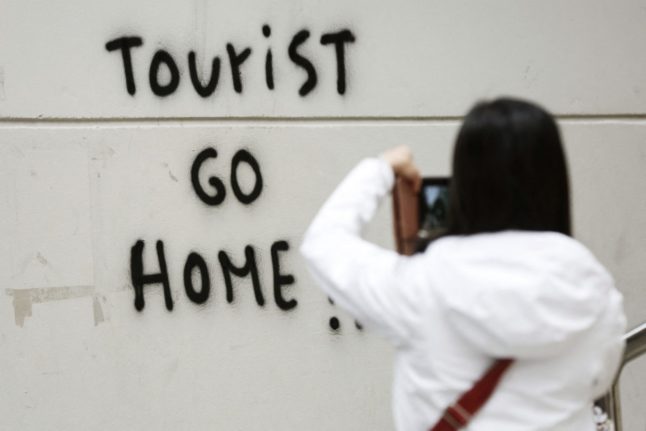Tourism has truly become a double-edged sword for many parts of Spain.
Whereas in previous decades el turismo offered new job possibilities to communities where fishing and agriculture were the only means of subsistence, and the main drawback were the brutalist high-rises that spoiled once-quaint villages and towns, now the industry is a far more complicated issue for Spain.
Every year, the Spanish government and media eagerly report a new record in holidaymaker numbers (84 million in 2023), often pitched as a competition with neighbouring France in terms of who can welcome the most international visitors.
It’s mass tourism (el turismo de masas), with the vast majority of foreign sun-seekers crammed in along Spain’s nearly 8,000km of coastline, while the interior remains largely unvisited and in some cases uninhabited.
Many will celebrate these figures as a win, tourism is after all Spain’s top industry in a service-based economy, the bread and butter of millions of Spaniards.
But ask any Spanish person how the type of tourist that visits their country differs from those who go on holiday to Italy and France and they’re likely to say that they’re drunker, more disrespectful, less interested in culture and overall not as affluent.
This is a more established problem of Spain’s cheap all-inclusive tourism model, and one that’s led to citizen campaigns in places like the Majorcan town of Magaluf as far back as 2014, where neighbours had already grown tired of the “drunkenness and unsociable behaviour” of young British and other northern European tourists.
Such was the frustration of locals that in 2018 the often-deadly practice known as balconing was mocked by Majorcans on social media and turned into a tongue-in-cheek competition, so see which nationality jumped off hotel balconies the most.
Barcelona is another place with a long-established anti-tourism sentiment, its central Gothic Quarter streets swamped with tour groups during the day and boozy stag-dos at night.
For the most part of the last decade, signs at beaches and graffiti painted on walls have shared the same message: “Tourists go home!”.
READ MORE:
Not that every holidaymaker in the Catalan capital goes there for just beach and sangría; a more cultured and wealthy holidaymaker has also flocked there and contributed to the more recent problem of over-tourism.
The proliferation of Airbnb and other holiday lets in recent years in Spain has meant that locals who rent are being forced to leave their barrios by landlords seeking bigger profits from short-term renting.
Málaga is the newest example of this happening, which explains why a sticker campaign has seen slogans such as “This used to be my home” (antes esta era mi casa), “go f*cking home” (a tu puta casa) and “stinking of tourist” (apestando a turista) plastered around the city centre.
Locals in Seville have done the same to protest against rising rents and the rise of holiday lets in once working-class neighbourhoods, albeit with the tourist misspelt (turist).
In another Andalusian city, Granada, much of the same turismofobia (touristphobia): “@tourist go away”.
In Ibiza in the Balearics, where rents during high season are unattainable, the same slogan has been voiced.
Even in the less visited northern coast of Spain, dozens of “tourist go home” tags have been sprayed in the city of San Sebastián.
READ ALSO: Which cities in Spain have new restrictions on tourist rentals?
In other parts of Spain such as the Canary island of Tenerife, the ‘Tourists go home’ message has more of an environmental connotation, with graffiti such as ‘My misery your paradise’ sprayed on the site of a new resort at La Tejita, an unspoilt beach which up to now authorities had prevented any building from happening on.
There’s also a dig at foreign digital nomads and remote workers who earn more and can afford to pay more for rent or to buy a home, with messages such as “average salary in the Canary Islands is €1,200”.
In neighbouring Gran Canaria, the message was even clearer: “tourist and digital nomad go home”.
READ ALSO: No, Spain’s Lanzarote is not looking to ditch British tourists
Increasing tourist numbers at hidden gem spots that once only locals knew but have since been discovered thanks to their ‘instagrammable’ nature are another source of anger. In 2023, activists on Mallorca put up fake signs with messages such as “beware of dangerous jellyfish” and “caution, falling rocks” in a bid to prevent the island’s beaches from being packed full of tourists.
All across Spain’s tourist hotspots, the message appears to be clear: reasonable living costs and a decent quality of life are now in short supply for locals.
Many Spaniards are still opposed to biting the hand that feeds them – tourism did account after all for €108 billion in income for the country in 2023 – but the general consensus is that authorities must do something to stem the uncontrolled gentrification that’s transforming Spanish towns and cities and worsening the lives of those who live in them.



 Please whitelist us to continue reading.
Please whitelist us to continue reading.
The gross side of British tourists has been on display since the mid 1960s not just since 2014!